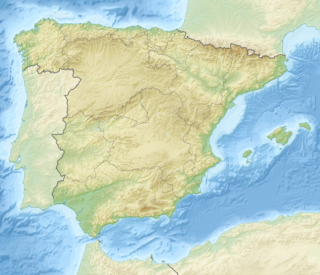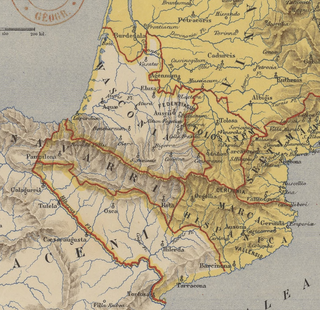 W
WThe Catalan earthquake of 2 February 1428, known in Catalan as the terratrèmol de la candelera because it took place during Candlemas, struck the region of Catalonia, especially Roussillon, with an epicentre near Camprodon. The earthquake was one of a series of related seismic events that shook Catalonia in a single year. Beginning on 23 February 1427, tremors were felt in March, April, 15 May at Olot, June, and December. They caused relatively minor visible damage to property, notably to the monastery of Amer; but they probably caused severe weakening of building infrastructure. This would account for the massive and widespread destruction that accompanied the subsequent 1428 quake.
 W
WThe Aragonese Crusade or Crusade of Aragon, a part of the larger War of the Sicilian Vespers, was declared by Pope Martin IV against King Peter III of Aragon in 1284 and 1285. Because of the recent conquest of Sicily by Peter, Martin declared a crusade against him and officially deposed him as king, on the grounds that Aragon was a papal fief: Peter's grandfather and namesake, Peter II, had surrendered the kingdom as a fief to the Holy See. Martin bestowed Aragon on Peter's nephew Count Charles of Valois, son of King Philip III of France.
 W
WThe Catalan counties were the administrative Christian divisions of the eastern Carolingian Hispanic Marches and southernmost part of the March of Gothia in the Pyrenees created after its Frankish quick counter conquest.
 W
WThe Catalan Courts or General Court of Catalonia was the policymaking and parliamentary body of the Principality of Catalonia from the 13th to the 18th century.
 W
WThe County of Aragon or County of Jaca was a small Frankish marcher county in the central Pyrenean valley of the Aragon river, comprising Ansó, Echo, and Canfranc and centered on the small town of Jaca, an area now part of Spain. It was created by the Carolingians late in the 8th or early in the 9th century, but soon fell into the orbit of the Kingdom of Navarre, into which it was absorbed in 922. It would later form the core of the 11th century Kingdom of Aragon.
 W
WThe County of Besalú was one of the landlocked medieval Catalan counties near the Mediterranean coastline. It was roughly coterminous with the modern comarca of Garrotxa and at various times extended as far north as Corbières, Aude, now in France. Its capital was the village of Besalú. Throughout most of its history it was attached to one of the other more powerful counties, but it experienced a century of independence before it was finally and irrevocably annexed to the County of Barcelona.
 W
WThe County of Cerdanya was one of the Catalan counties formed in the last decades of the 8th century by the Franks in the Marca Hispanica. The original Cerdanya consisted of the valley of the upper Segre. Today Cerdanya is a Catalan comarca.
 W
WThe County of Conflent or Confluent was one of the Catalan counties of the Marca Hispanica in the ninth century. Usually associated with the County of Cerdanya and the county of Razès, and was located to the west of Roussillon. It largely corresponded to the modern comarca of Conflent.
 W
WThe County of Osona, also Ausona, was one of the Catalan counties of the Marca Hispanica in the Early and High Middle Ages. It was based around the capital city of Vic (Vicus) and the corresponding diocese, whose territory was roughly the current comarca of Osona.
 W
WThe County of Pallars Jussà or Lower Pallars was a county in the Hispanic March during the eleventh and twelfth centuries, long after the march had ceased to be effectively administered by the Kings of France. It was a division of the County of Pallars, which had been de facto, and possible de jure, independent since the late ninth century. It roughly corresponded with the modern Catalan comarca of Pallars Jussà.
 W
WThe County of Pallars Sobirà or (Pallás) Sobirá, meaning Upper Pallars, was a county in the Hispanic Marches during the eleventh and twelfth centuries, long after the march had ceased to be effectively administered by the Kings of France. It was a division of the County of Pallars, which had been de facto, and possible de jure, independent since the late ninth century. It roughly corresponded with the modern Catalan comarca of Pallars Sobirà.
 W
WThe County of Roussillon was one of the Catalan counties in the Marca Hispanica during the Middle Ages. The rulers of the county were the counts of Roussillon, whose interests lay both north and south of the Pyrenees.
 W
WThe Hispanic Marches or Spanish Marches, also known as the March of Barcelona, were a military buffer zone beyond the former province of Septimania, established by Charlemagne in 795 as a defensive barrier between the Umayyad Moors of Al-Andalus and the Frankish Carolingian Empire.
 W
WThe House of Cabrera was an important Catalan dynasty. It began to rule in the Viscounty of Girona, which would be called Viscounty of Cabrera, as well as the Viscounty of Àger, the Sicilian County of Modica and the County of Urgell.
 W
WThe Liber feudorum maior, originally called the Liber domini regis, is a late twelfth-century illuminated cartulary of the Crown of Aragon. It was compiled by the royal archivist Ramon de Caldes with the help of Guillem de Bassa for Alfonso II, beginning in 1192. It contained 902 documents dating as far back as the tenth century. It is profusely illustrated in a Romanesque style, a rarity for utilitarian documents. The LFM is an indispensable source for the institutional history of the emerging Principality of Catalonia. It is preserved as a file in the Arxiu de la Corona d'Aragó (ACA), Cancelleria reial, Registres no. 1, in Barcelona.
 W
WThe Order of the Hatchet is a female honorific order supposedly founded in 1149, bestowed upon the women of the town of Tortosa, in Catalonia (Spain).
 W
WThe Principality of Catalonia was a medieval and early modern state in the northeastern Iberian Peninsula. During most of its history it was in dynastic union with the Kingdom of Aragon, constituting together the Crown of Aragon. Between the 13th and the 18th centuries, it was bordered by the Kingdom of Aragon to the west, the Kingdom of Valencia to the south, the Kingdom of France and the feudal lordship of Andorra to the north and by the Mediterranean sea to the east. The term Principality of Catalonia remained in use until the Second Spanish Republic, when its use declined because of its historical relation to the monarchy. Today, the term Principat (Principality) is used primarily to refer to the autonomous community of Catalonia in Spain, as distinct from the other Catalan Countries, and usually including the historical region of Roussillon in southern France.
 W
WThe Raid of 904 was a military campaign of the Emirate of Cordova against the counties of Pallars and Ribagorza.
 W
WThe vegueria was the feudal administrative territorial jurisdiction of the Principality of Catalonia during the Middle Ages and into the Modern Era until the Nueva Planta decrees of 1716. The vegueria was headed by a veguer and its office was called a vigeriate.